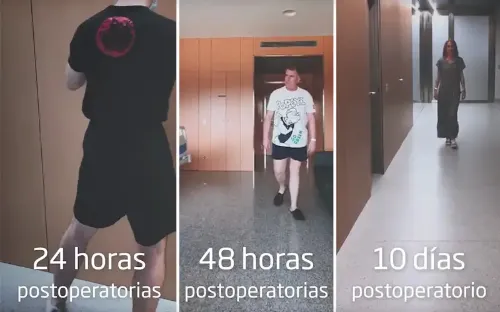Minimally invasive surgery for hip prosthesis
"It is a technique that has no limitations and the benefits are a rapid recovery and in the long term, the ability to regain full mobility of the hip".
DR. PABLO DÍAZ DE RADA SPECIALIST. ORTHOPEDIC SURGERY AND TRAUMATOLOGY DEPARTMENT

Minimally invasive anterior hip replacement surgery is a major advance in the treatment of patients with hip arthrosis.
Being a technique with an anterior approach, the surgeon accesses between the muscles, without damaging them, respecting the anatomical elements of the body. This allows a much faster recovery than with the conventional procedure, while minimizing pain, the size of the incision and the hospital stay.

When is minimally invasive surgery for the hip indicated?
The anterior hip prosthesis is a minimally invasive technique that has no limitation in terms of indications to be able to perform it.
This technique is very novel for sports patients, because they will be able to continue with their physical activity without restriction of movement after the operation (although they will have to avoid contact sports) and also for people with obesity, because the accumulation of fat in the inguinal region is less than in the back.
Do you have osteoarthritis of the hip that limits your quality of life?
You can benefit from minimally invasive surgery in advance
How is previous minimally invasive surgery performed?
Choice of surgery type
First a pre-surgical planning is done to evaluate the alteration that the patient presents and the prosthesis that best fits his needs to adapt it to the anatomy of each patient.
The approach is performed anteriorly and a "bikini" incision is used that will be hidden under clothing, causing the minimum aesthetic impact on the patient's life.
The conventional interventions to treat the hip (performed by posterior route, that is, through the buttock) suppose to disinsert (to remove) the muscles to be able to implant the hip prosthesis, reason why later it is necessary to reconstruct that musculature. However, with this technique the surgeon accesses between the muscles, without damaging them, respecting the anatomical elements of the body.
Thanks to an intraoperative x-ray we make sure that the size of the prosthesis is the best adapted.
In the medium term, the dislocation capacity of the hip prosthesis is reduced to practically 0 and the patient is allowed any type of movement from the first post-operative day.
Postoperative recovery
Four hours after the surgery, the patient can already walk with crutches and after 48 hours can return home with a very advanced recovery in terms of pain reduction and increased autonomy. With the traditional technique, discharge from the hospital is even extended to the seventh day," he explains.
Furthermore, with the conventional procedure, after the operation the patient must avoid certain movements because they could cause a dislocation (dislocation) of the prosthesis, something that does not happen with this minimally invasive technique because, by not disinserting the muscles, they retain their stability.
With this technique a quick recovery is achieved and in the long term, an ability to recover all the mobility and physical activity that the patient may need.

MINIMALLY INVASIVE SURGERY
Outpatient hip replacement
Avoiding hospitalization is possible thanks to a prosthesis implantation technique that preserves the muscles and the development of a multidisciplinary protocol that enables faster recovery.
Where do we do it?
IN NAVARRE AND MADRID
The Department of Orthopedic Surgery and Traumatology
of the Clínica Universidad de Navarra
The Department of Orthopedic Surgery and Traumatology covers the full spectrum of congenital or acquired conditions of the musculoskeletal system including trauma and its aftermath.
Since 1986, the Clinica Universidad de Navarra has had an excellent bank of osteotendinous tissue for bone grafting and offers the best therapeutic alternatives.
Organized in care units
- Hip and knee.
- Spine.
- Upper extremity.
- Pediatric orthopedics.
- Ankle and foot.
- Musculoskeletal tumors.

Why at the Clinica?
- Experts in arthroscopic surgery.
- Highly qualified professionals who perform pioneering techniques to solve traumatological injuries.
- One of the centers with the most experience in bone tumors.




















